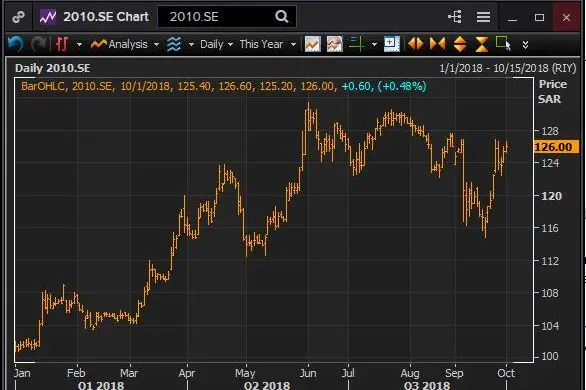PHOTO
Brent Crude oil prices have added 24.58 percent since the start of the year, driving a rally in petrochemical shares on the Saudi market.
“Oil prices have hit highs this year not seen since the crash in 2014, reflecting positively on petrochemical shares,” Issam Kassabieh, senior financial analyst and head of research at Menacorp Finance told Zawya.
Fears of supply tightening, as a result of sanctions set to be imposed on Iran by the United States from November, has pushed prices to levels not seen for four years, with Brent Crude hovering near $83 on Monday.
As a result, JP Morgan raised its Brent Crude forecast for the next six months to $85, according to its latest note, up from a previous forecast in the low $60s. According to the bank, a spike of Brent to $90 is likely, an analysts said in a note.
Higher oil prices were one of the main factors that helped push the Saudi market to add 11.16 percent so far this year.
“One of the risks surrounding oil prices is the Chinese compliance with the sanctions on Iranian oil, especially after the latest round of trade tensions between China and the U.S.” Kassabieh said.
“The petrochemical sector has also strengthened as a result of the mergers and acquisitions talks in Saudi Arabia,” he added, refering to Saudi Aramco's bid to buy a controlling stake in petrochemical giant, Saudi Basic Industries Corporation (SABIC) (Read more here).
SABIC has also bought a 24.99 percent stake in Switzerland's Clariant (Read more here).
SABIC, the kingdom’s largest company by market capitalization ($97.91 billion/SAR 367.20 billion), has tracked a rise in oil prices during 2018, with the company’s stock adding 23.00 percent so far since the start of the year.
According to data from Thomson Reuters’ Eikon, one analyst gave a ‘strong buy’ rating on the SABIC stock, four analysts gave a ‘buy’ rating and seven analysts have rated it as ‘hold’.
“The stock looks a bit rich from a fundamental perspective with a forward price to earnings (P/E) of 16-17x versus a historical normalized P/E of around 15x,” Yousef Husseini, head of the Chemicals team at EFG Hermes told Zawya by email.
“The stock looks even more pricey when you consider the fact that prices and margins year-to-date have been higher than normalized levels, so earnings today are likely to be higher than normalized levels and are not necessarily sustainable in the long run.”
“With that said, during any MSCI/FTSE event, multiples tend to rerate by a substantial amount and while SABIC is reflecting higher than normal multiples, there is likely more room to run if the trend is similar to Qatar, UAE or Pakistan,“ Husseini added.
“As such, while I’d be fundamentally neutral on the name at these levels, from a tactical perspective the multiple could still expand further from here.”
Other petrochemical companies have also seen gains during the year. Petro Rabigh surged 41.97 percent, Saudi Kayan Petrochemical added 58.05 percent, Yanbu National Petrochemicals added so far 19.99 percent.
Husseini said about the rest of the petrochemical sector: “Valuations are a mixed bag, with some stocks looking relatively cheap while others look more expensive.”
“But the sector as a whole still offers tactical upside in my view, given the large amount of flows expected, a generally healthy operating environment versus other sectors in Saudi (e.g. most sectors in Saudi are suffering from recent reforms), and undemanding valuations in some cases.”
OPEC released on September 23, 2018 its yearly World Oil Outlook, predicting a higher demand for petrochemicals: “Demand growth in industry is driven mainly by the petrochemical sector, with demand forecast to increase by 4.5 million barrel per day from 2017-2040.”
“Oil prices have also boosted valuations for UAE stocks like Dana Gas and TAQA which have done well this year,” Mencacorp Finance’s Kassabieh told Zawya.
Dana Gas added 45.68 percent so far in 2018, while TAQA gained 109.09 percent.
The Saudi market closed 0.48 percent higher on Monday, Dubai’s index gained 0.52 percent, Abu Dhabi’s index added 0.9 percent, Oman’s index edged 0.12 percent lower, Bahrain’s index dropped 0.26 percent while Qatar’s index dropped 0.24 percent and Kuwait’s index retreated 0.27 percent.
(Reporting by Gerard Aoun; Editing by Shane McGinley)
(gerard.aoun@thomsonreuters.com)
Our Standards: The Thomson Reuters Trust Principles
Disclaimer: This article is provided for informational purposes only. The content does not provide tax, legal or investment advice or opinion regarding the suitability, value or profitability of any particular security, portfolio or investment strategy. Read our full disclaimer policy here.
© ZAWYA 2018












